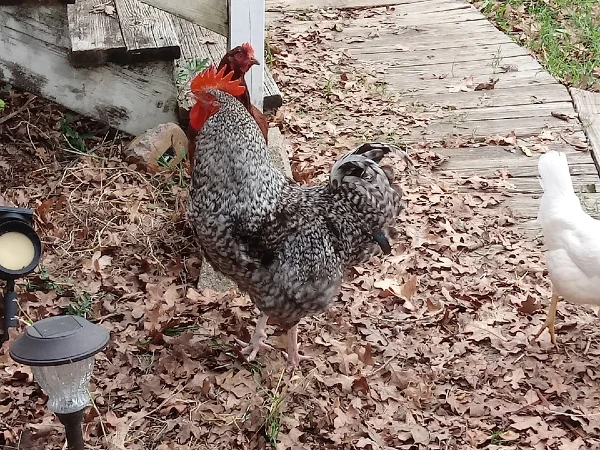The Plymouth Rock chicken is a great breed of chicken that has been around for over 100 years. If you are looking to get this breed, then the growth charts of the Plymouth Rock chicken in this article will be helpful in understanding their growth rate week by week, so that you can better care for them.

The Use of the Chicken
This birds has been bred as dual-purpose chicken. This means that the chicken will be able to get a lot of eggs and make good meat.
The birds that have been bred as dual-purpose chickens provide a balance between egg laying and meat production, which also makes them more economically efficient to raise in a backyard.
You can expect to get around 200 eggs per year from your Plymouth Rock hen, which is pretty much impressive for a breed that is not used only for eggs.
The Plymouth Rock chicken has the potential to be a large bird.
When fully grown, a Plymouth Rock chicken weighs around 6.5 to 7.5 pounds for hens and roosters respectively.
Since they can get fairly large, one of the most important things you can do as your chicken matures is provide ample space in their coop.
This way they will grow strong, healthy and happy!
To help beginners understand how these birds grow, I have created a week by week growth chart.
Plymouth Rock Chicken Growth Chart
It is worth noting at this point that the study of the growth rate of Plymouth Rock chicken was made using White Rocks. The study was made by the College of Agriculture at the University of Missouri.
| Age in Weeks | Weight of White Plymouth Rock Pullets in Pounds |
| 0 | 0.090 |
| 4 | 0.39 |
| 8 | 1.07 |
| 12 | 1.88 |
| 16 | 2.55 |
| 20 | 3.09 |
| 24 | 3.59 |
| 28 | 4.22 |
| 32 | 4.69 |
| 36 | 4.92 |
| 40 | 5.04 |
From the above Plymouth Rock growth chart we can see that a 40-week old pullet weighs in at around 5 pounds, while a 20 week old one can only be expected to weigh about 3 lbs.
The following chart shows the average weight gain for a Plymouth Rock pullet every four weeks.
| Age in Weeks | Gains by 4 weeks of Pullets in Pounds |
| 0-4 | 0.31 |
| 5-8 | 0.68 |
| 9-12 | 0.81 |
| 13-16 | 0.68 |
| 17-20 | 0.54 |
| 21-24 | 0.50 |
| 25-28 | 0.64 |
| 29-32 | 0.47 |
| 33-36 | 0.24 |
| 37-40 | 0.13 |
Plymouth Rock Growth Chart – Cockerel vs Pullet
When comparing the growth rate of Plymouth Rock pullets and cockerels, we can see that the best gains were during the 9-12 week interval.
During the first 4 weeks there was very little difference between pullets and cockerels but from then on they diverged greatly.
| Age in Weeks | Cockerel | Pullet |
| 0 | 0.090 | 0.089 |
| 4 | 0.41 | 0.39 |
| 8 | 1.22 | 1.09 |
| 12 | 2.41 | 1.93 |
| 16 | 3.20 | 2.63 |
| 20 | 4.03 | 3.15 |
Just so you know, a cockerel is a male chicken that is under 1 year old. A pullet is a female chicken that has not yet reached maturity, which is before 1 year of age.
What Can Influence on Growth Rate of Plymouth Rocks?
You have probably heard one of those advices usually told by experience chicken owners, that you need to start chicks relatively early in the season.
One of those arguments to early hatching is that, compared with later hatchlings, chickens will grow faster.
Studies show that chicks hatched in early February will be heavier when they are 20 weeks of age, than chicks hatched in April when they are 20 weeks of age.
However, by the 28 weeks of age they will be the same weight.
The study made by the Collage of Agriculture at Missouri demonstrated that there was no weight difference between chicks hatched early or later in the season.
All chicks can grow differently and all respond to the environment in their own way.
Some individuals grow relatively fast when young and slower as they approach maturity, while others grow relatively slow when young.
All in all, there are many factors that can influence on the growth rate of the Plymouth Rocks, or any other breed in general. The feed type, the temperature, the amount of sunshine or humidity can all influence the rate at which chicks develop.
You can expect to have different growth rate of Rhode Island Red for example.
Conclusion
You should know that Rocks are a great breed of chicken, and they have been around for over 100 years.
I hope this article will help you understand the growth rate of Plymouth Rock so that you can better care for them.
If you are looking to get chickens in your backyard, then I would recommend getting Plymouth Rocks because they are known as one of the best breeds available!
